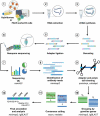NAb-seq: an accurate, rapid, and cost-effective method for antibody long-read sequencing in hybridoma cell lines and single B cells
- PMID: 35965451
- PMCID: PMC9377246
- DOI: 10.1080/19420862.2022.2106621
NAb-seq: an accurate, rapid, and cost-effective method for antibody long-read sequencing in hybridoma cell lines and single B cells
Abstract
Despite their common use in research, monoclonal antibodies are currently not systematically sequenced. This can lead to issues with reproducibility and the occasional loss of antibodies with loss of cell lines. Hybridoma cell lines have been the primary means of generating monoclonal antibodies from immunized animals, including mice, rats, rabbits, and alpacas. Excluding therapeutic antibodies, few hybridoma-derived antibody sequences are known. Sanger sequencing has been "the gold standard" for antibody gene sequencing, but this method relies on the availability of species-specific degenerate primer sets for amplification of light and heavy antibody genes and it requires lengthy and expensive cDNA preparation. Here, we leveraged recent improvements in long-read Oxford Nanopore Technologies (ONT) sequencing to develop Nanopore Antibody sequencing (NAb-seq): a three-day, species-independent, and cost-effective workflow to characterize paired full-length immunoglobulin light- and heavy-chain genes from hybridoma cell lines. When compared to Sanger sequencing of two hybridoma cell lines, long-read ONT sequencing was highly accurate, reliable, and amenable to high throughput. We further show that the method is applicable to single cells, allowing efficient antibody discovery in rare populations such as memory B cells. In summary, NAb-seq promises to accelerate identification and validation of hybridoma antibodies as well as antibodies from single B cells used in research, diagnostics, and therapeutics.
Keywords: Antibody sequencing; B cell; hybridoma; long-read; nanopore sequencing; rat B cell cloning; single cell; workflow.
Conflict of interest statement
The authors report there are no competing interests to declare.
Figures




Similar articles
-
A simplified workflow for monoclonal antibody sequencing.PLoS One. 2019 Jun 24;14(6):e0218717. doi: 10.1371/journal.pone.0218717. eCollection 2019. PLoS One. 2019. PMID: 31233538 Free PMC article.
-
Barcoded sequencing workflow for high throughput digitization of hybridoma antibody variable domain sequences.J Immunol Methods. 2018 Apr;455:88-94. doi: 10.1016/j.jim.2018.01.004. Epub 2018 Jan 20. J Immunol Methods. 2018. PMID: 29357282
-
Cloning, reformatting, and small-scale expression of monoclonal antibody isolated from mouse, rat, or hamster hybridoma.Methods Mol Biol. 2014;1131:207-28. doi: 10.1007/978-1-62703-992-5_13. Methods Mol Biol. 2014. PMID: 24515468
-
Hybridoma technologies for antibody production.Immunotherapy. 2011 Mar;3(3):371-80. doi: 10.2217/imt.11.4. Immunotherapy. 2011. PMID: 21395379 Review.
-
Antibodies and Selection of Monoclonal Antibodies.Adv Exp Med Biol. 2016;917:11-22. doi: 10.1007/978-3-319-32805-8_2. Adv Exp Med Biol. 2016. PMID: 27236550 Review.
Cited by
-
Can antibodies be "vegan"? A guide through the maze of today's antibody generation methods.MAbs. 2024 Jan-Dec;16(1):2343499. doi: 10.1080/19420862.2024.2343499. Epub 2024 Apr 18. MAbs. 2024. PMID: 38634488 Free PMC article. Review.
-
Mutational profiling of SARS-CoV-2 papain-like protease reveals requirements for function, structure, and drug escape.Nat Commun. 2024 Jul 23;15(1):6219. doi: 10.1038/s41467-024-50566-9. Nat Commun. 2024. PMID: 39043718 Free PMC article.
-
De novo antibody identification in human blood from full-length single B cell transcriptomics and matching haplotype-resolved germline assemblies.Genome Res. 2025 Apr 14;35(4):929-941. doi: 10.1101/gr.279392.124. Genome Res. 2025. PMID: 40118521 Free PMC article.
-
Restrander: rapid orientation and artefact removal for long-read cDNA data.NAR Genom Bioinform. 2023 Dec 23;5(4):lqad108. doi: 10.1093/nargab/lqad108. eCollection 2023 Dec. NAR Genom Bioinform. 2023. PMID: 38143957 Free PMC article.
-
Fetal bovine serum: how to leave it behind in the pursuit of more reliable science.Front Toxicol. 2025 Aug 8;7:1612903. doi: 10.3389/ftox.2025.1612903. eCollection 2025. Front Toxicol. 2025. PMID: 40861932 Free PMC article. Review.
References
Publication types
MeSH terms
Substances
LinkOut - more resources
Full Text Sources
